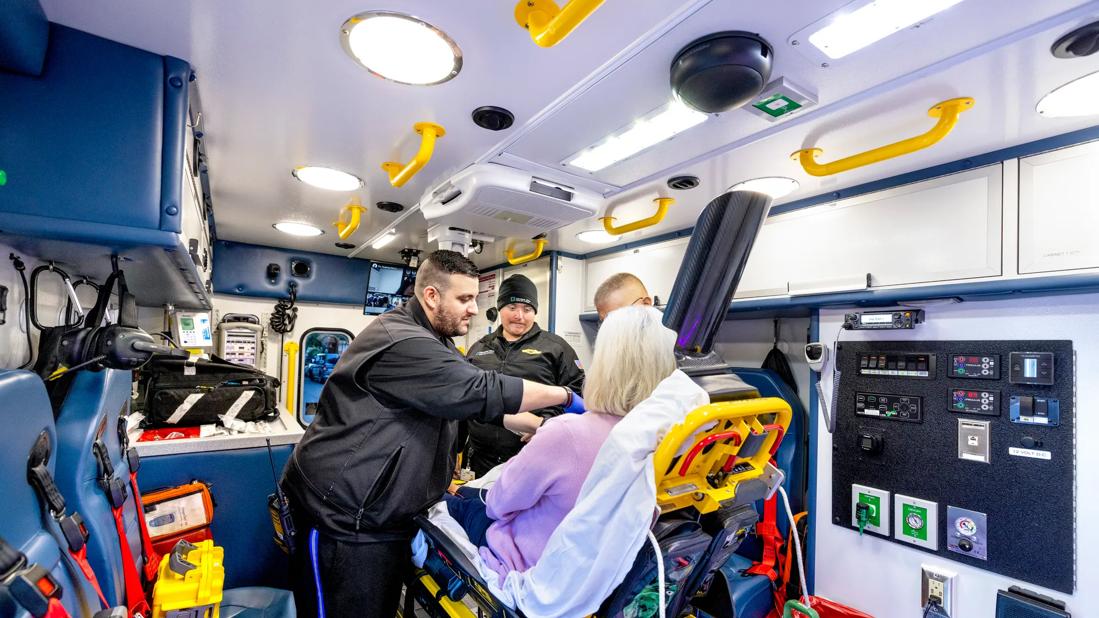Study compares financial impacts of clinical and geographic factors

Mobile stroke units (MSUs) are a less-costly strategy than standard prehospital care and transport of stroke patients once thresholds of certain variables, such as number of cases and likelihood of needing transfer to a Comprehensive Stroke Center, are reached. So finds a cost-consequence analysis based on Cleveland Clinic’s experience with its MSU published recently in Frontiers in Neurology.
Advertisement
Cleveland Clinic is a non-profit academic medical center. Advertising on our site helps support our mission. We do not endorse non-Cleveland Clinic products or services. Policy
“Triaging acute stroke on the scene using mobile stroke units and directly sending patients to the most appropriate hospital can save not only critical time compared with traditional emergency medical care, but it can save costs as well,” says study co-author Ken Uchino, MD, a stroke neurologist and Head of Research and Education in Cleveland Clinic’s Cerebrovascular Center.
Whether MSUs can be a financially feasible service is a subject of debate. Given that they are ambulances equipped to allow full stroke assessment, including CT and angiography, and initiation of thrombolytic therapy with tPA when indicated, MSUs require both a large capital outlay and substantial operating costs. In the case of Cleveland Clinic’s MSU, the initial outlay included telemedicine capability so that cases can be managed by vascular neurologists and neuroradiologists via two-way video.
Previous Cleveland Clinic studies have demonstrated that MSUs are associated with improved time to treatment and better clinical outcomes (as described in ConsultQD posts here and here), consistent with findings from other centers. Other published studies have assessed various aspects of cost-effectiveness associated with MSUs, but the units’ improved ability to transport patients to an appropriate facility from the start, thus avoiding emergency room visits and interhospital transfers, has not been explored.
The current study involved a cost-consequence analysis comparing incremental costs associated with the following:
Advertisement
Only patients with suspected stroke after initial evaluation by the telemedicine neurologist were included. The analysis was conducted from the hospital perspective and included all events from the emergency call to the point of hospital admission.
Of 400 patients transported by the MSU in the study period, 331 (83%) were diagnosed with stroke or suspected ischemic stroke and 24 were diagnosed with hemorrhagic stroke (the other 45 cases had other medical issues). Among the patients with stroke, 52 required transport to a Comprehensive Stroke Center, with 28 being eligible for neurovascular intervention.
Not surprisingly, the costs of operating the MSU (including labor and maintenance) made it more costly over the course of a year than standard transport ($856,482 vs. $785,869, respectively). Hence, the annual incremental cost of the MSU vs. standard transport for treating the same patient population was $70,613.
Use of the MSU averted 76 emergency department visits and 76 interhospital transfers.
Sensitivity analysis identified the following variables as having a measurable impact on the model, with values in parentheses indicating the threshold at which the MSU becomes more cost-effective versus standard transport:
Advertisement
Dr. Uchino identifies several points of interest from the study, as outlined below.
Freeing up emergency resources was accomplished with modestly increased costs. “Enabling patients to be directly admitted to the appropriate hospital improves efficiency of healthcare delivery and is an important factor when considering cost-effectiveness,” he says. He adds that an annual incremental cost of about $70,000 for the MSU can be considered a modest expense, in light of averting emergency department services and duplicated testing. Interhospital transfers can quickly become a large expense: Helicopter flights alone cost about $7,000 per trip, on average. The model calculated that cost savings realized by avoiding secondary interhospital transfers alone could account for about 35% of the annual operating cost of the MSU.
The model was conservative with respect to recoverable costs. The analysis assumed that none of the aspects of MSU care was reimbursable by third-party payers. In the real world, billing of transport and services is likely and would increase cost-effectiveness of the MSU strategy.
The analysis did not account for improved clinical outcomes attributable to MSUs. Ongoing studies assessing clinical benefits of MSUs, including reduced disability and medical costs, will inform more comprehensive future cost analyses of MSUs vs. standard transport.
MSUs likely make sense only for certain geographic areas. The cost-effectiveness of MSUs depends on resources already available to a community, Dr. Uchino notes. For example, a population close to a Comprehensive Stroke Center may not gain from improved transportation if a standard ambulance can quickly transport a stroke patient directly to it.
Advertisement
“The thresholds we identified provide important information for regional planning to determine whether an MSU should be part of healthcare services,” he concludes.
Advertisement
Advertisement

Large NIH-funded investigation is exploring this understudied phenomenon

Advances in genomics, spinal fluid analysis, wearable-based patient monitoring and more

Case study of radial-to-axillary nerve transfer for tumor-related deltoid nerve injury

An update on the technology from the busiest Gamma Knife center in the Americas

Real-time adjustments may help reduce bothersome dyskinesias

Anatomical modeling can identify optimal surgical candidates, study suggests

Add AI to the list of tools expected to advance care for pain patients

New guidelines from Brain Trauma Foundation urge early and aggressive treatment